The foundry technology developed earlier in China. During the period of Shangzhou, the foundry technology in China was quite developed and many exquisite objects were produced. Now the technology has strengthened the casting accuracy and improved the technological process, which makes the foundry industry present a new blood. At present, the foundry industry in China is still relatively backward compared with some developed countries, so China urgently needs to open up a new world in the foundry industry.
1、 Current situation of foundry industry in China
China is the largest casting production country in the world. According to the data, the output value of China’s casting products accounts for about 1% in the national economy. In recent years, the import and export trade of castings has increased rapidly, and the output of castings has reached about 9%. There are more than 20000 foundry sites and 1.2 million foundry employees in China. The “Yangtze River Delta” region’s casting output accounts for 1 / 3 of the whole country, and the region is mainly dominated by private enterprises. The development of automobile and auto parts industry has strongly promoted the development of the casting industry. Wanfengott is the largest aluminum alloy wheel enterprise in Asia, with an annual output value of more than 1 billion yuan and an export volume of 6000 US dollars. Kunshan fujiwa Machinery Co., Ltd. produces castings for automobile engines and brake systems, with an annual output of 40000 tons and a sales revenue of 550 million yuan. East China taikexi is an advanced modern cylinder block casting production enterprise, with an annual production capacity of 1 million car cylinder block castings. Shanxi is a province with large foundry resources. It is rich in pig iron, coal, aluminum and magnesium, power and labor resources, which makes Shanxi’s foundry industry have unique advantages. It has 500 foundry enterprises, 80% of which are private enterprises. The annual output of Shanxi International, Hejin Shanlian and Shanxi Huaxiang reached 40000 tons, 20000 tons and 120000 tons respectively. “Three eastern provinces” have FAW Group, Hafei group and other key automobile enterprises, which have driven the growth of automobile casting production. FAW Group foundry company has formed a production capacity of 400000 tons of castings. Liaoning North crankshaft Co., Ltd. will form a crankshaft production base with an annual output of 150000 engines, 1 million crankshafts and an output value of 2 billion by the end of the 11th five year plan. The “Pearl River Delta” die casting industry is developed, with more than 700 die-casting enterprises and an annual output of 200000 tons. Dongfeng Nissan, Guangzhou Honda, Guangzhou Toyota and parts enterprises have strongly promoted the development of die casting industry, and the output of die casting parts for car cylinder block and cylinder head has increased year by year.
2、 Current situation of foreign foundry industry
In recent years, the global casting industry has continued to grow. In 2004, the output of castings increased by 8.4% compared with the previous year. China produced 22.42 million tons of castings, ranking first in the world, an increase of 23.6% compared with the previous year. In 2004, China’s casting output accounted for about 1 / 4 of the global casting output. Brazil’s casting production increased the fastest, reaching 25.8%. The countries with growth rates of more than two figures are Brazil, China, Mexico and India, all of which are developing countries. The growth rate of castings in developed countries is generally low. Casting production in the United States has dropped to the second place since 2000. In 2004, the total output of castings in the United States was 12.31 million tons, including 35% gray iron castings, 33% ductile iron castings, 8.4% steel castings and 16% aluminum alloy castings. In terms of demand, the demand for ductile iron castings and aluminum castings is increasing. In 2003, imported castings accounted for 15% of the total demand, and the price of imported castings was 20% – 50% lower than that of domestic castings. In recent years, due to the high requirements of casting environmental protection, large energy consumption, high labor cost and other reasons, the foundry factories of large American automobile companies producing ordinary automobile castings have closed down, and gradually turned the production of castings to developing countries such as China, India, Mexico, Brazil, etc. Japan’s foundry industry is in a slump, with fewer workers. In 2004, the total output of castings in Japan was 6.39 million tons, of which 42% were gray iron castings, 30% were nodular iron castings, 4% were steel castings and 21% were aluminum alloy castings. In terms of demand, the demand for ductile iron castings and aluminum castings is increasing. A lot of work has been done in the field of technology innovation in Japan, including the development of nodular low expansion casting sand, high damping cast iron material, medium silicon heat-resistant nodular iron and other materials. The casting of the vacuum die casting can be welded and heat treated, and the semi-solid casting can be used for the production of automobile aluminum hub, which improves the strength and elongation. Magnesium alloy die casting develops further and replaces gravity casting, which improves its performance and reduces its cost.

